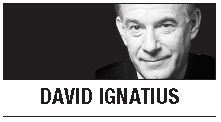WASHINGTON ― The hundred pages of Benghazi emails released last week tell us almost nothing about how four Americans came to die so tragically in that Libyan city. But they are a case study in why nothing works in Washington.
Rather than reading these messages for their substance on Benghazi (on which officials were still basically clueless three days after the attack), try perusing them as an illustration of how the bureaucracy responds to crisis ― especially when officials know they will be under the media spotlight.

What you find is a 100-page novella of turf-battling and backside-covering. By the end, the original product is so shredded and pre-chewed that it has lost most of its meaning. All the relevant agencies have had their say, and there’s little left for the public.
No wonder that CIA Director David Petraeus, who began the exercise when he met with House intelligence committee members for coffee on the morning of Sept. 14, was unhappy with the effort. He complained that “this is certainly not what ... [the committee] was hoping to get for unclas. use” and growled: “Frankly. I’d just as soon not use this.”
But in a typical Petraeus happy-talk sign off, he ended his message: “Regardless, thx for the great work.” What he should have said was: “This has been sanitized to the point of incoherence. Start over.” With his attaboy, the document was sent out to the intelligence committee and thence to the world.
Perhaps it’s because I’m a spy novelist myself, but I couldn’t resist reading the thick stack of emails as an epistolary tale of life in the bureaucracy. No, it’s not Samuel Richardson’s model of storytelling by letters, as in his classic of the genre, “Clarissa.” But it does remind me a bit of the first novel by Charles McCarry, America’s master espionage novelist, titled “The Miernik Dossier,” which is written as a series of cables and other documents.
The Benghazi emails have all been unclassified of course, but they reveal one of the true secrets of American national-security policy ― which is its lumpy inefficacy. If I were the Russian or Chinese intelligence services trying to understand how America really works (or doesn’t), I’d start here.
Take a stroll with me through these memorably inane pages. CIA officials take turns patting each other on the back with comments such as “Good question,” “Good point.” And tellingly, from the very beginning, CIA officers are looking over their shoulders for what the lawyers will say: “Make sure that nothing we are saying here is likely to impact any future legal prosecution.” This at a time when the agency’s priority, surely, should have been understanding who did the attack, not their prospective legal rights.
Then the cascade of bureaucratic log-rolling and pettifoggery begins, as each new agency is called to the trough. The office of the director of national intelligence is copied, belatedly, and then the White House. Then it’s over to State Department spokesman Victoria Nuland, who has all kinds of problems with the detail-rich draft, which she fears “will come back to us at podium” ― and from there, the neutering of the text begins in earnest.
By the time it’s over, the overcrowded editors’ desk will include the FBI, the Justice Department and the NSA ― in addition to many, many officials at the CIA, State Department and White House. At 8:40 p.m. Friday evening, when the scrubbing has been underway for hours, Jacob Sullivan, the wunderkind adviser to Secretary of State Hillary Clinton, ventures (not unreasonably): “I do not understand the nature of the exercise.”
White House media wranglers sense trouble ahead, given that the talking points will be parsed by news media who are properly curious about what the heck happened in Benghazi. NSC spokesman Tommy Vietor warns “there is massive disinformation out there, in particular with Congress.” Senior press guru Ben Rhodes weighs in at 9:34 p.m. and warns of feeding “a ton of wrong information” and creating “a hardened misimpression.” Sorry, Ben, but I don’t think the counter-the-spin effort worked too well.
The final editor proves to be Michael Morell, the deputy director of the CIA, the next morning. He takes what started as six information-rich bullet points and whittles them down to an information-thin three points.
At the bottom of the stack of message traffickers is the office of U.N. Ambassador Susan Rice, who is appointed to deliver the talking points on the Sunday talk shows. And then, as we know, the Benghazi imbroglio really begins.
By David Ignatius
David Ignatius’ email address is davidignatius@washpost.com. ― Ed.
(Washington Post Writers Group)







![[Exclusive] Hyundai Mobis eyes closer ties with BYD](http://res.heraldm.com/phpwas/restmb_idxmake.php?idx=644&simg=/content/image/2024/11/25/20241125050044_0.jpg)
